Back to: BIOLOGY SS2
Welcome to Class !!
We are eager to have you join us !!
In today’s Biology class, We will be learning about the Circulatory System. We hope you enjoy the class!
CONTENT
- Protective Function of Blood
- Circulatory System in Mammals
- Blood Vessels and the Heart
PROTECTIVE FUNCTION OF BLOOD
The blood performs two basic functions in mammals and
These are:
- Transportation of various substances
- Protection of body against diseases
The blood defends the body in major ways
- Antibody production (Clumping): The lymphocytes produce antibodies which are any of a large variety of proteins normally present in the body or produced in response to an antigen which it neutralizes, thus producing an immune response. This can also be ensured by injecting a small dose of the weaker or dead pathogens into the body. This process is known as vaccination or immunization
- Neutralization: The whole blood will also produce antitoxins which neutralize the toxins produced by the pathogens.
- Phagocyte Action (Engulfing): Phagocytes engulf the pathogens and digest them.
- Clotting: The blood platelets clot the blood to prevent germs from entering the body and also prevent loss of blood.
MECHANISM OF CLOTTING
When a blood vessel is damaged and exposed to air, platelets in the bloodstream release an enzyme thrombokinase. The thrombokinase then converts prothrombin (inactive blood protein) to an enzyme called thrombin. The thrombin then converts the soluble fibrinogen in the plasma to insoluble fibrin in the presence of calcium ions. The threadlike fibrin then forms a network or mesh on the surface of the wound and blood cells are trapped within the network or mesh to form a clot. The clot dries to scab over the wound.
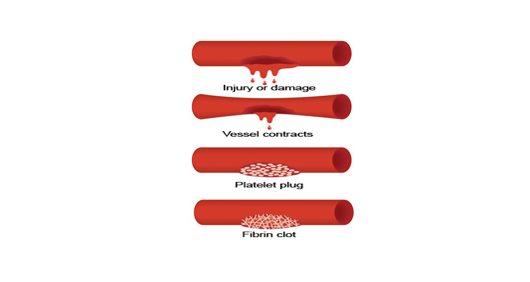
EVALUATION
- Describe the mechanism of blood clotting.
- What is vaccination?
TYPES OF CIRCULATORY SYSTEM
The circulatory system in animals can be:
- Closed or open
- Single or double
Closed Circulatory System: This involves the blood vessel called arteries which divides capillaries which later join up with other vessels called veins. Blood is therefore limited to the vessels and the heart it does not have direct contact with the body cells this system is observed in annelids and vertebrates.
Opened Circulatory System: The blood vessels lead out of the heart but end in blood spaces called haemocoels within the body cavity. The blood has direct contact with the cells after which it is returned to the heart. Arthropods and some molluscs have an open circulatory system
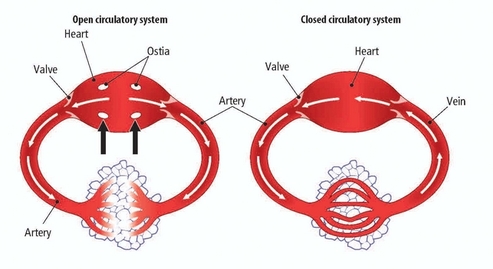
Single Circulatory System: The blood passes through the heart once in a complete movement round the body e.g. fishes because of their two-chambered heart have a single circulatory system.
Double Circulatory System: The blood passes twice in the heart every time it makes one complete movement around the body. Each time it passes through a separate pathway e.g. mammals. Double circulation gives rise to pulmonary and systematic circulation.
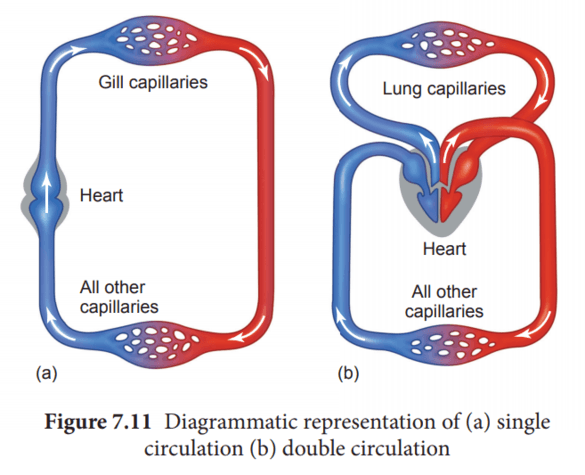
BLOOD VESSELS
- Arteries: These are vessels that carry oxygenated blood away from the heart to the body’s organs except for pulmonary artery that carries deoxygenated blood.
- Arteriole: A branch of an artery that gives rise to capillaries.
- Veins: These are large vessels that carry deoxygenated blood toward the heart except for pulmonary vein which carries oxygenated blood.
- Venule: Small vessel that carries blood from the capillaries to the veins.
- Capillaries: They link the arteries with the veins around the tissues and organs. They are tiny and thin-walled to facilitate easy exchange of gasses nutrients and waste products between the cells and the blood.
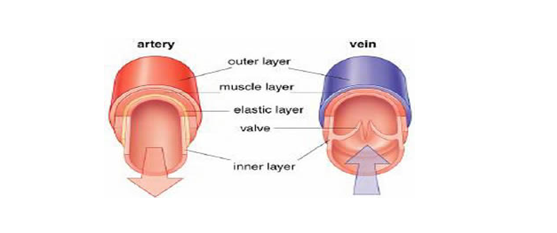
EVALUATION
- Define (a) artery (b) venule (c) capillary
- What is a double circulatory system?
DIFFERENCES BETWEEN ARTERY AND VEIN
| ARTERY | VEIN | |
| 1 | It has a thick (muscular walls) | It has a thin wall |
| 2 | Elastic wall | Non-elastic wall |
| 3 | Carries blood away from the heart | Returns blood to the heart |
| 4 | Carries oxygenated blood except for pulmonary artery | Carries deoxygenated blood except for the pulmonary vein |
| 5 | Blood is pink or bright in colour | Blood is dark red in colour |
| 6 | Situated deep in muscles | Superficially situated |
| 7 | Has small lumen | Large lumen |
| 8 | Pressure is high | Pressure is low |
| 9 | Pulse is readily detectable | Pulse is not easily detected |
| 10 | It has no valve except semilunar valves | It has valves |
THE HEART
The heart is a muscular and powerful organ responsible for pumping blood in the system of mammals. It is located within the chest cavity and protected in the ribs and sternum. The pumping action of the heart is known as the heartbeat. Heartbeat per second varies from animal to animal and is often increased at moments of excitement e.g. Humans’ heart is about 72 beats per minutes.
The special muscles making up the heart is known as cardiac muscles and the heart is enclosed in a two-layered tough protective membrane called the pericardium. Pericardial fluid fills the space between the heart and pericardium. It reduces the friction arising from the pumping movement of the heart against its surrounding tissues.
STRUCTURE OF THE HEART
The human heart is divided into four chambers, the right and left auricles, the right and left ventricles. The walls of the ventricles are often thicker than those of the auricles. The left ventricles especially have a thick wall because it pumps blood out to all other parts of the body and this requires more pressure.
The heart is divided into two halves by a central barrier called the septum. Bicuspid valves separate the left auricle and the left ventricle. This ensures that blood flows only in one direction i.e. from the auricles to the ventricles. Similarly, the tricuspid valve exists between the right auricle and the right ventricle. It serves the same function as the former. These bicuspid valves are held in place by special fibres, non-elastic cords known as chordae tendineae.
HEARTBEAT
The heartbeat consist of alternate contractions and relaxation of the right and left auricles as well as the right and left ventricle. The human heartbeat is about 72 beat per minutes this can be divided into two phases, namely
- Diastole: This is the first stage of the heartbeat; the two auricles contract forcing blood into the ventricles and oxygenated blood into the left ventricle. As the ventricles get filled up, the cuspid valves are pushed up and closed.
- Systole: This is the second phase of the heartbeat. The ventricles contract sending blood out to the two tracks of the main arteries and out of the heart. Deoxygenated blood from the right ventricles passes into the pulmonary artery while oxygenated blood is sent into the aorta. The sequence repeats itself.
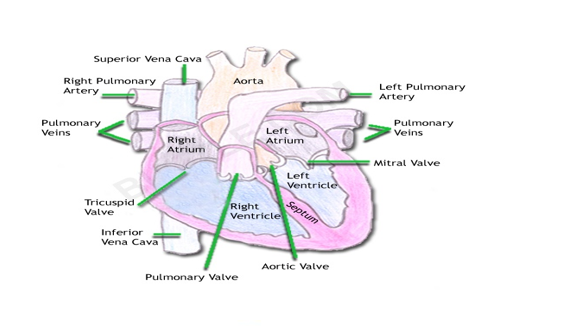
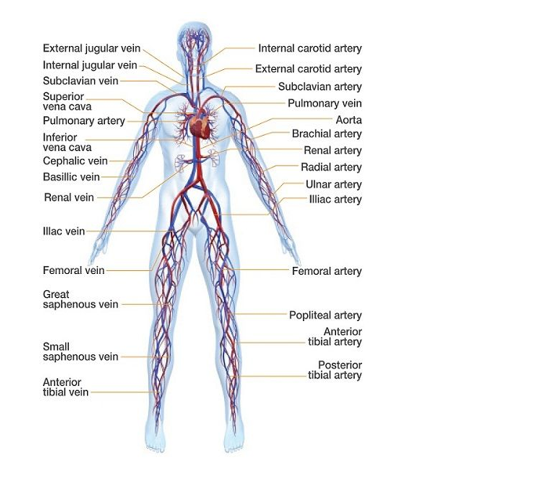
BLOOD VESSELS AND ORGANS SUPPLIED.
Blood Vessel (Artery) Organ Supplied
- Carotid artery ……. Head
- Pulmonary artery …….. Lungs
- Hepatic artery …….. Liver
- Gastric artery …….. Stomach
- Mesenteric artery …….. Intestine
- Renal artery ……… kidney
- Gonadal artery ……… Gonads
- Intercostals artery ……… Wall of thorax
Corresponding veins accompany the arteries stated above
GENERAL EVALUATION
- Draw a well-labelled diagram of the heart
- Differentiate between arteries and veins
- Explain systole and diastole.
- Draw the cross-section of the artery
- What is pulmonary circulation?
Reading Assignment
College Biology, Chapter 7, Page 136 – 157
WEEKEND ASSIGNMENT
SECTION A
- The following are the basic functions of blood except A.Transportation of substances B. Reproduction C. Protection of the body D. Transportation of hormones
- ………. is actively involved in preventing excessive loss of blood at injury A. Red blood cell B. White blood cell C. Platelet D. Serum
- The following except one have closed circulatory system. A. Snail B. Earthworm C. man D. lion
- The semilunar valve is present in A. Arteries B. Veins C. Capillaries D. Bladder
- The human heartbeat is …….. per minute A. 60 B. 66 C. 72 D. 80
SECTION B
- With a well-labelled diagram only, describe the structure of the heart.
- State the differences between arteries and veins
We have come to the end of this class. We do hope you enjoyed the class?
Should you have any further question, feel free to ask in the comment section below and trust us to respond as soon as possible.
In our next class, we will be learning about Transport System in Higher Plants. We are very much eager to meet you there.

The best
Wonderfull
What causes inability of blood clotting
haemophilia
Inability of blood clotting, also known as coagulopathy, can be caused by several factors. Here are some key causes:
1. **Genetic Disorders**: Conditions like hemophilia, where specific clotting factors are deficient or absent, lead to difficulty in forming clots.
2. **Liver Disease**: Since the liver produces many of the proteins necessary for blood clotting, liver dysfunction (like cirrhosis) can impair clotting ability.
3. **Vitamin K Deficiency**: Vitamin K is essential for synthesizing certain clotting factors. A deficiency can result from malnutrition, certain medications, or malabsorption disorders.
4. **Medications**: Anticoagulants (like warfarin or heparin) and some other medications can interfere with the clotting process, leading to increased bleeding.
5. **Blood Disorders**: Conditions like thrombocytopenia (low platelet count) or disseminated intravascular coagulation (DIC) can affect the body’s ability to clot.
6. **Autoimmune Disorders**: Some autoimmune diseases can attack the body’s own clotting factors or platelets, hindering the process
haemophilia
General functions of the blood
Please I need the functions of the heart list and explanation
Discuss the rate of fibrinogen thromplatin
Thank you 😊